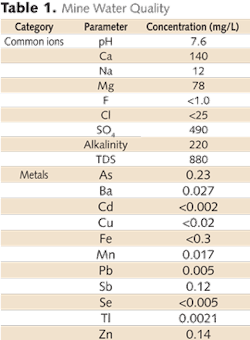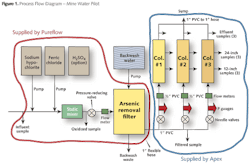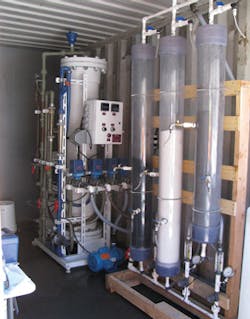Mine Water Treatment: Coagulation/Filtration Technology Helps Remove Arsenic, Antimony at NV Mine
Veris Gold, owner and operator of the Jerritt Canyon Mine near Elko, Nev., must dewater the Smith Mine at the canyon in order to access more ore for mining operations. However, arsenic and antimony (Sb) concentrations in this pH-neutral groundwater exceed Maximum Contaminant Levels (MCLs).
The project goals are to: 1) oxidize arsenic and antimony; 2) reduce arsenic concentrations from 200-300 µg/L to below the MCL of 10 µg/L; 3) reduce antimony concentrations from 100-150 µg/L to below the MCL of 6 µg/L; and 4) treat flow rates of 1,000 to 6,000 gallons per minute (gpm).
Arsenic is a common element in the earth's crust, natural groundwater and even the human body. It is typically found as an oxyanion in the environment, most commonly in the +3 and +5 oxidation states. Speciation of Smith Mine water arsenic revealed it to be about 50% As(III) and 50% As(V). Much of the behavior assumed for antimony stems from characteristics of arsenic -- its better-known metalloid relative. Typical quality of Smith Mine water is shown in Table 1.
Treatment Technologies
A cost-effective approach for arsenic removal is iron coagulation and precipitation followed by filtration, termed coagulation/filtration (CF). Common methods of coagulating arsenic and antimony are iron coagulation, alum coagulation and lime softening. Alum coagulation is generally less efficient than iron coagulation, so alum should only be used in systems with low arsenic concentrations, which is not the case at the Smith Mine.
Accordingly, lime softening is a common technique used to precipitate metals from solution. Many remedial full-scale designs exist in the U.S. today but do not achieve low effluent arsenic concentrations. In water containing high arsenic concentrations, a pretreatment step generally precedes iron addition. Following coagulation, a process such as multimedia filtration with automated backwashing is generally used to remove precipitated arsenic and/or antimony.
While CF is effective, new adsorbent materials are being developed to remove metals from solution. Adsorptive media (AM) is another common technology for arsenic removal that can be used in place of, or in conjunction with, CF. Most adsorptive media used for arsenic removal are iron-based; variations include titanium dioxide, zirconium and other ion exchange resins. As with CF systems, a variety of equipment and materials suppliers are available.
Pilot Testing
The first step in selecting a treatment system for the Smith Mine was to examine CF and AM systems currently used to remove arsenic and antimony, along with recent advances in technology. For example, two relevant treatment systems were recently installed to remove arsenic and antimony from drinking water in Alta, Utah. One system uses a CF process to remove primarily arsenic, while the other system uses AM to remove arsenic and antimony. Both systems were designed and installed by Pureflow Filtration. We visited the Alta site and were impressed with the Pureflow systems. We decided to pilot-test the Pureflow processes at Jerritt Canyon, using both CF and AM.
Pureflow Coagulation/Filtration
Our first focus area for pilot testing was CF; Figure 1 shows a schematic of the pilot system for Smith Mine water. The CF system from Pureflow on the left side of Figure 1 includes sodium hypochlorite for oxidation and ferric chloride for coagulation, along with sulfuric acid for possible pH reduction to enhance coagulation and/or adsorption.
Pureflow supplied a 12-inch-diameter filter filled with PM200M media. A typical hydraulic loading rate used for CF with a moderate iron dose is 4 gpm/ft2, which is a flow rate of 3 gpm for this size filter.
It has been demonstrated in many studies that arsenic removal depends on the iron-to-arsenic (Fe:As) ratio in water. Fe:As ratios up to 100 were evaluated by adding ferric chloride. Further, economic analysis showed that arsenic and antimony removal up to a point is more cost-effective using a CF process rather than AM, so early pilot testing focused on maximizing removal of arsenic and antimony.
Figure 2 shows arsenic removal at increasing Fe:As ratios. Arsenic removal appears to be asymptotic, with removal above 90 percent achieved at Fe:As ratios above 20. Antimony removal at increasing Fe:As ratios is shown in Figure 3. Pilot test data revealed this relationship to be more linear than with arsenic removal, although earlier jar test data (shown in red) showed antimony removal to asymptotically increase at higher Fe:As ratios.
Very high Fe:As ratios are required to achieve substantial antimony removal. Ferric chloride is a relatively inexpensive chemical, but this approach generates a much higher solids loading rate, requiring more filters and a higher capital cost. Subsequent economic analysis showed that an Fe:As ratio of about 25 appears optimum to:
- Achieve arsenic removal of 90 percent or greater.
- Achieve antimony removal of about 15 percent.
- Minimize the number of filters required after iron coagulation.
Adding more filters, which would be necessary with a reduced filter loading rate at higher Fe:As ratios, would only be economical if treatment were in place for at least eight years. Antimony can definitely be removed to below the MCL -- it
is only a matter of whether CF or AM is more economical.
Pilot Test 1
The second focus area for pilot testing was adsorptive media, which would "polish" the remaining arsenic and remove most of the antimony. Similar to Alta, we set up 6-inch columns with clear PVC to evaluate several types of adsorptive media in parallel (see Fig. 4). Preceding these columns was the CF system designed by Pureflow, which had already demonstrated near-complete arsenic removal. The columns on the right side of Figure 4 can simultaneously evaluate three types of adsorptive media.
Pilot Test 1 used three different adsorptive media types in 6-inch upflow columns: Graver Technologies (GT), ResinTech (RT) and Pure Effect (PE). A conservative hydraulic loading rate for adsorptive media is 5 gpm/ft2, which equals a flow of 1 gpm per column for these 6-inch-diameter columns. Therefore, the Pureflow CF system operating at 3 gpm supplied enough feed water for three AM columns. Sampling ports were installed in the columns at media depths of 1 foot, 2 feet and 3 feet. Terms used in evaluating the results are:
- Bed volumes (BV) = Water volume treated/media volume
- Empty bed contact time (EBCT) = Media volume/flow rate
- Loading or adsorption capacity = Total contaminant removed (mg)/media mass (g)
- Breakthrough = Time (days or months) at which a certain concentration (such as the MCL) is reached in treated water
Pilot Test 1 operated in upflow mode, which is how many biological treatment systems are operated; however, most adsorptive media and ion exchange processes operate in downflow mode. We believe that the relatively poor performance of GT media over the first 5,000 BV was due to operating in upflow mode, which fluidized the media and allowed some bypassing of untreated water.
Likewise, we feel that results from 5,000 to 15,000 BV (operating in downflow) are more representative of what the GT media can deliver. Loading of the three media are shown in Figure 5, with GT media far exceeding the other two. GT media, which was used at Alta, was the only media that met the antimony MCL of 6 µg/L.
The pilot test flow rate of 1 gpm per column provided an EBCT of 4.5 minutes, which is a typical value for adsorptive media systems. This EBCT translates to treating about 10,000 BV per month.
Pilot Test 2
While seeing relatively poor antimony removal in Pilot Test 1 operating in upflow mode, Pureflow set up an available
3-inch-diameter column to operate in the typical downflow mode. This column was set up and shipped to Jerritt Canyon while Pilot Test 1 was underway. This test also evaluated MetSorb media from Graver Technologies (GT media).
Pilot Test 2 operated in conjunction with the end of Pilot Test 1. After the Pure Effect AM column was discontinued due to poor removal (see Fig. 5), water was available to run through the 3-inch column. A flow rate of about 0.23 gpm produced a hydraulic loading rate of 5 gpm/ft2.
Results from Pilot Test 2 are shown in Table 2. This shows that antimony "breakthrough" (a concentration exceeding the detection limit of 3 µg/L) was seen after about 5,400 BV at Sampling Port 1, which is a media depth of 1 foot. The loading at that location and time was 0.84 mg antimony per g of media, or 840 µg/g, compared to 285 µg/g reported for iron oxide-coated sand.
Comparison to Alta Results
The Alta, Utah, drinking water plant, which uses the Pureflow system with titanium dioxide media from Graver Technologies, started up in late 2009. The adsorptive media system uses two AM tanks (called Tank A and Tank B) in series. Antimony concentrations at Alta are shown in Figure 6. Tank B effluent (with concentrations well below the MCL) is blended with untreated water to meet the MCL for drinking water.
Media in Tank A has not been changed yet because it is still removing some antimony (see Fig. 6). A comparison of conditions and results between the Smith Mine and Alta is shown in Table 3. Smith Mine results are from the 3-inch downflow column in Pilot Test 2. Loading capacities are similar, but the number of bed volumes at the Smith Mine is much lower because of the much higher antimony concentration.
Summary
The most economical process for Smith Mine water appears to be CF followed by titanium dioxide adsorptive media. Two pilot tests demonstrated that the MCLs for both arsenic (10 µg/L) and antimony (6 µg/L) can be met with this process. Pilot test results with Smith Mine water are similar to full-scale results obtained with titanium dioxide at a drinking water plant in Alta, Utah. IWW
About the Authors: Mark Reinsel, Ph.D., P.E. is president of Apex Engineering, PLLC in Missoula, Mont., and has 30 years of experience in consulting, industry and academia. His consulting work focuses on treating mining and other industrial wastewaters through biological, chemical and physical methods. Reinsel is a registered professional engineer in Montana and Nevada.
Gideon Sarpong is a project/environmental engineer for Veris Gold USA Inc. at the Jerritt Canyon Mine Site. He has five years of experience, with expertise focusing on water and wastewater engineering.
John Barta, B.Sc. geology and B.Sc. mining engineering, is environmental manager for Veris Gold USA Inc. at the Jerritt Canyon Mine Site. He has 29 years of environmental work experience with the last 24 years on hard rock mine sites. Barta has managed all aspects of air and water pollution control, permitting and compliance, and mine site closure and restoration.
Archived IWW Issues






